Kanto Tourism offers a diverse range of experiences, from the bustling metropolis of Tokyo to serene natural landscapes. SIXT.VN provides convenient travel solutions, ensuring a seamless and unforgettable journey through this captivating region of Japan. Explore iconic landmarks, cultural treasures, and breathtaking scenery with ease.
1. What Makes Kanto Region a Great Tourist Destination?
The Kanto region is a fantastic tourist destination because of its unique blend of modern urban landscapes and traditional Japanese culture, offering something for every traveler. This region encompasses Tokyo and six other prefectures, each with its own distinct attractions, from historical sites to natural wonders.
- Diverse Attractions: The Kanto region is home to iconic landmarks such as Tokyo Skytree, historical sites in Nikko, and the natural beauty of Hakone.
- Accessibility: With efficient transportation systems, including trains and buses, it’s easy to explore various parts of the Kanto region.
- Cultural Experiences: Visitors can immerse themselves in traditional Japanese culture through temples, gardens, and festivals.
- Culinary Delights: The Kanto region offers a wide array of culinary experiences, from Michelin-starred restaurants to local street food.
- Seasonal Beauty: Each season brings a unique charm to the Kanto region, from cherry blossoms in spring to vibrant foliage in autumn.
2. What Are The Must-Visit Cities In The Kanto Region For First-Time Travelers?
For first-time travelers, Tokyo, Yokohama, and Kamakura are must-visit cities in the Kanto region, offering a blend of modern attractions and historical sites. Each city provides a unique glimpse into Japanese culture and lifestyle.
- Tokyo: As the capital of Japan, Tokyo is a vibrant metropolis with countless attractions, including the bustling Shibuya Crossing, the historic Asakusa district, and the trendy Shinjuku Gyoen National Garden.
- Yokohama: This port city offers a cosmopolitan atmosphere with attractions like the iconic Yokohama Landmark Tower, the historic Red Brick Warehouse, and the serene Sankeien Garden.
- Kamakura: Known for its historical significance, Kamakura is home to the iconic Great Buddha statue at Kotoku-in Temple and numerous other temples and shrines, offering a glimpse into Japan’s rich cultural heritage.
3. What Are The Best Kanto Tourism Attractions In Tokyo?
Tokyo offers a plethora of attractions catering to diverse interests, making it a highlight of Kanto tourism. From historical sites to modern marvels, Tokyo has something for everyone.
- Senso-ji Temple: Asakusa’s iconic temple, offering a glimpse into Tokyo’s traditional past.
- Shibuya Crossing: The world’s busiest intersection, a symbol of Tokyo’s vibrant urban life.
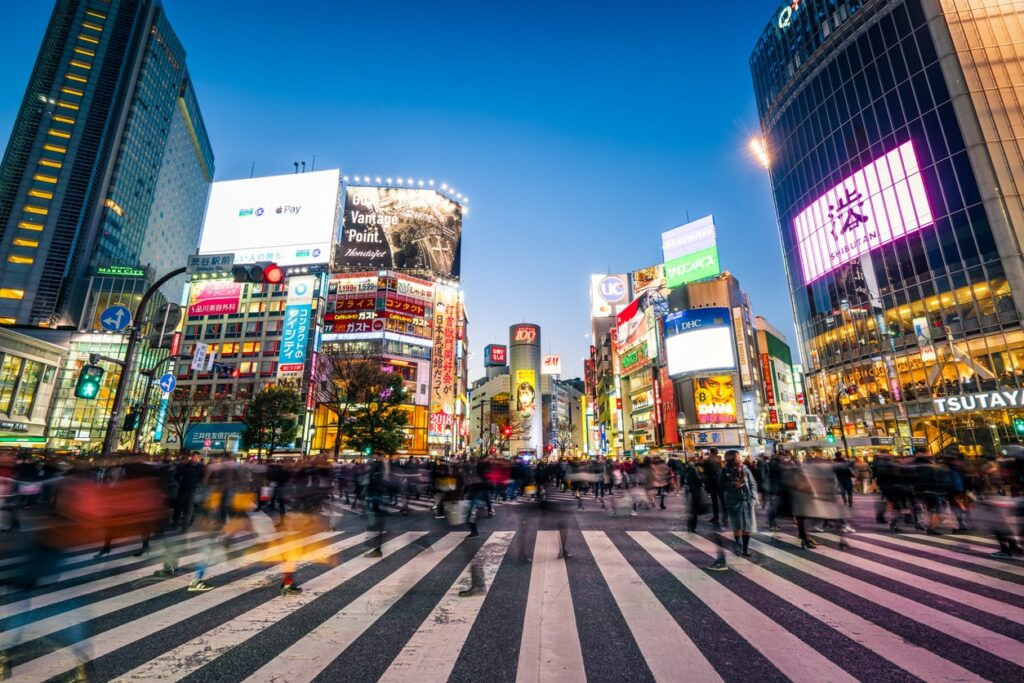 Shibuya Crossing Tokyo
Shibuya Crossing Tokyo
alt: The iconic Shibuya Crossing in Tokyo, a symbol of the city’s energetic urban culture.
- Tokyo Skytree: Offering panoramic views of the city from its observation decks.
- Imperial Palace East Garden: The former site of Edo Castle, now a public park showcasing Japanese history and horticulture.
- Ueno Park: A sprawling park home to several museums, a zoo, and beautiful gardens.
- Ginza District: Known for its upscale shopping, dining, and entertainment options.
- Shinjuku Gyoen National Garden: A tranquil oasis amidst the bustling city, featuring diverse garden styles.
- Meiji Jingu Shrine: A peaceful shrine dedicated to Emperor Meiji and Empress Shoken.
- Ghibli Museum: A whimsical museum dedicated to the works of Studio Ghibli (reservations required).
- Akihabara: The electric town, known for its electronics retailers, anime and manga shops, and themed cafes.
4. What Outdoor Activities and Natural Scenery Can Be Found in Kanto?
The Kanto region boasts a diverse range of outdoor activities and natural scenery, perfect for nature lovers and adventure seekers. From mountains to coastlines, there’s plenty to explore.
- Mount Takao: A popular hiking destination near Tokyo, offering scenic trails and panoramic views.
- Hakone: Known for its stunning views of Mount Fuji, hot springs, and picturesque lakes.
 Hakone Kanagawa Ropeway Lake
Hakone Kanagawa Ropeway Lake
alt: The Hakone Ropeway offering stunning views of Lake Ashi and surrounding mountains in Kanagawa.
- Nikko National Park: Home to ancient shrines, temples, and beautiful waterfalls, surrounded by lush forests.
- Chiba’s Boso Peninsula: Offering scenic coastal drives, hiking trails, and opportunities for water sports.
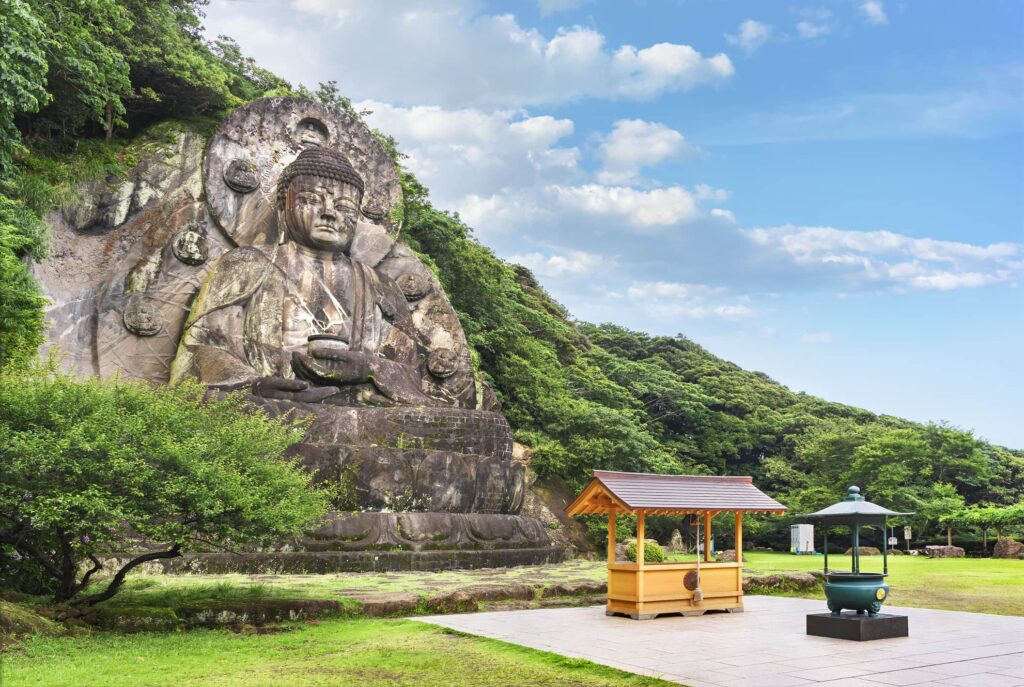 Boso Peninsula, Chiba
Boso Peninsula, Chiba
alt: The rugged coastline of the Boso Peninsula in Chiba, offering hiking and scenic views.
- Ibaraki’s Hitachi Seaside Park: Famous for its seasonal flower displays, including the iconic blue nemophila flowers in spring.
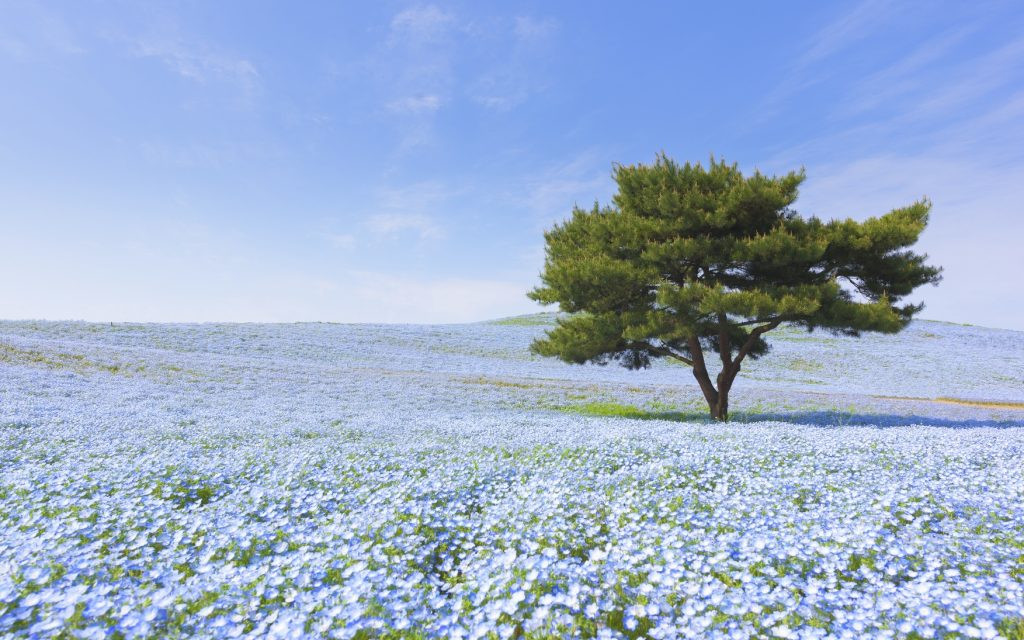
alt: The vibrant blue nemophila flowers blooming in Hitachi Seaside Park, Ibaraki, during springtime.
- Gunma’s Mountains: Offering opportunities for skiing in the winter and canyoning in the summer.
5. What Cultural Experiences are Unique to the Kanto Region?
The Kanto region is rich in cultural experiences that offer insights into Japan’s history, traditions, and arts. These unique activities provide a deeper understanding of Japanese culture.
- Visiting Historic Temples and Shrines: Explore ancient sites like Senso-ji Temple in Tokyo and Tsurugaoka Hachimangu Shrine in Kamakura.
- Participating in Traditional Festivals: Experience local customs and celebrations at festivals like the Sanja Matsuri in Tokyo.
- Attending Sumo Wrestling Tournaments: Witness the excitement of Japan’s national sport at the Ryogoku Kokugikan in Tokyo.
- Exploring Traditional Gardens: Stroll through beautifully landscaped gardens like Shinjuku Gyoen National Garden in Tokyo and Sankeien Garden in Yokohama.
- Taking Part in Tea Ceremonies: Experience the art of tea preparation and enjoy the serene atmosphere of a traditional tea ceremony.
- Visiting Museums and Art Galleries: Discover Japanese art and history at museums like the Tokyo National Museum and the Ghibli Museum.
- Exploring Historic Towns: Wander through the streets of towns like Kawagoe in Saitama, known for its well-preserved Edo-era architecture.
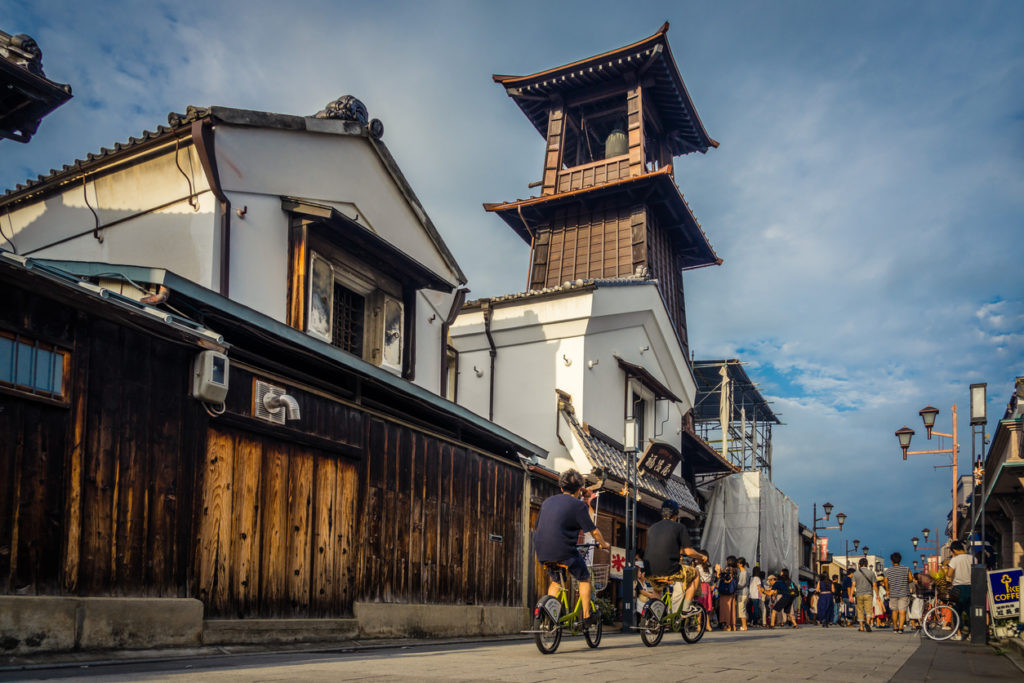 Kawagoe old town in Saitama.
Kawagoe old town in Saitama.
alt: The historic streets of Kawagoe in Saitama, showcasing traditional Edo-era architecture.
6. How Can SIXT.VN Enhance Your Kanto Tourism Experience?
SIXT.VN enhances your Kanto tourism experience by providing comprehensive travel solutions, including personalized itinerary planning, airport transfers, hotel bookings, tour reservations, and flight arrangements. SIXT.VN ensures convenience, reliability, and expert support throughout your journey.
- Personalized Itinerary Planning: SIXT.VN offers customized itineraries tailored to your interests, ensuring you see the best of the Kanto region.
- Convenient Airport Transfers: Start your trip stress-free with reliable airport transfer services to and from Narita and Haneda airports.
- Wide Range of Hotel Options: Choose from a variety of hotels to suit your budget and preferences, from luxury accommodations to cozy guesthouses.
- Guided Tours and Excursions: Discover the Kanto region with expert-led tours, providing insights into local culture and history.
- Easy Flight Bookings: Find the best flight deals and convenient travel options to and from Japan with SIXT.VN’s flight booking services.
- 24/7 Customer Support: Enjoy peace of mind with round-the-clock customer support, ensuring assistance whenever you need it.
With SIXT.VN, your Kanto tourism experience will be seamless, enjoyable, and filled with unforgettable memories.
7. What Are Some Day Trip Ideas From Tokyo Within The Kanto Region?
Several day trip options from Tokyo within the Kanto region offer diverse experiences, from historical sites to natural beauty. These destinations are easily accessible and provide a refreshing break from the city.
- Hakone: Known for its stunning views of Mount Fuji, hot springs, and art museums.
- Kamakura: Home to the iconic Great Buddha statue and numerous temples and shrines.
- Nikko: Featuring ancient shrines and temples nestled in beautiful natural surroundings.
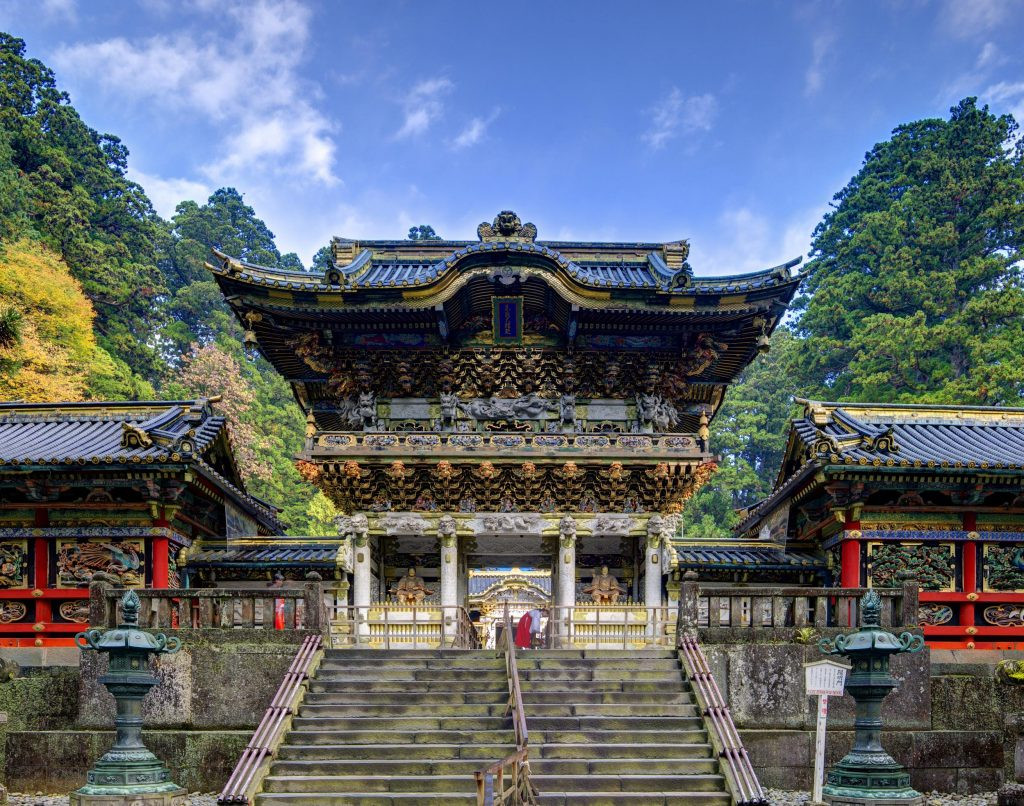 Nikko, Japan – November 1, 2012: A shinto priest sweeps under the Yomeimon gate at Tosho-gu Shrine. Founded in 1617, the remains of the first shogun Tokugawa Ieyasu are entombed here.
Nikko, Japan – November 1, 2012: A shinto priest sweeps under the Yomeimon gate at Tosho-gu Shrine. Founded in 1617, the remains of the first shogun Tokugawa Ieyasu are entombed here.
alt: A Shinto priest sweeping under the Yomeimon gate at Toshogu Shrine in Nikko, Tochigi, a UNESCO World Heritage Site.
- Kawagoe: A charming town with well-preserved Edo-era architecture and traditional candy shops.
- Yokohama: A cosmopolitan port city with attractions like the Red Brick Warehouse and Chinatown.
- Mount Takao: A popular hiking destination offering scenic trails and panoramic views.
8. What Are The Best Times To Visit The Kanto Region For Optimal Tourism?
The best times to visit the Kanto region for optimal tourism are spring (March to May) and autumn (September to November), when the weather is pleasant and the scenery is at its most beautiful. These seasons offer unique experiences and attractions.
- Spring (March to May): Enjoy the cherry blossoms (sakura) in full bloom, creating stunning landscapes in parks and gardens. According to the Japan Meteorological Agency, cherry blossoms typically bloom in Tokyo in late March or early April, making it a perfect time for hanami (flower viewing) parties.
- Autumn (September to November): Witness the vibrant foliage (koyo) as the leaves change color, creating breathtaking scenery in mountainous areas like Nikko and Hakone. The Japan National Tourism Organization (JNTO) highlights autumn as one of the best times to visit Japan, with comfortable temperatures and picturesque landscapes.
- Summer (June to August): Experience summer festivals and outdoor activities, but be prepared for hot and humid weather.
- Winter (December to February): Enjoy clear skies and fewer crowds, with opportunities for skiing and snowboarding in the mountains.
9. What Are Some Unique Foods to Try in The Kanto Region?
The Kanto region offers a variety of unique foods that reflect its culinary heritage and regional specialties. From traditional dishes to modern creations, there’s something to satisfy every palate.
- Monjayaki (Tokyo): A savory pancake similar to okonomiyaki, cooked on a hot griddle and eaten with a small spatula.
- Chankonabe (Tokyo): A hearty stew popular among sumo wrestlers, packed with meat, vegetables, and noodles.
- Yokohama Chinatown Cuisine (Yokohama): Explore a wide range of Chinese dishes in one of the largest Chinatowns in the world.
- Soka Senbei (Saitama): Crispy rice crackers seasoned with soy sauce, a popular snack in Saitama.
- Tsukemen (Tokyo): A style of ramen where the noodles are served separately from the broth, allowing you to dip them as you eat.
- Strawberry Picking (Tochigi): Enjoy fresh, locally grown strawberries at one of Tochigi’s many strawberry farms.
10. How Can I Plan a Budget-Friendly Trip to The Kanto Region?
Planning a budget-friendly trip to the Kanto region involves several strategies, from transportation to accommodation and dining. By making smart choices, you can enjoy a memorable trip without breaking the bank.
- Take Advantage of Public Transportation: The JR Tokyo Wide Pass is a cost-effective option for exploring the Kanto region. According to JR East, this pass offers unlimited travel on JR lines within the designated area for three consecutive days.
- Stay in Budget-Friendly Accommodations: Consider hostels, guesthouses, or Airbnb options instead of expensive hotels.
- Eat at Local Restaurants and Markets: Enjoy affordable and delicious meals at local eateries and markets.
- Visit Free Attractions: Many parks, temples, and shrines offer free admission, allowing you to explore the region without spending a lot of money.
- Travel During Off-Peak Seasons: Avoid traveling during peak seasons like Golden Week and New Year’s to save on flights and accommodations.
- Utilize Free Wi-Fi: Take advantage of free Wi-Fi hotspots to avoid data roaming charges.
- Look for Discounted Tickets and Passes: Many attractions offer discounted tickets for students, seniors, or tourists.
By following these tips, you can plan an affordable and enjoyable trip to the Kanto region.
Conclusion
The Kanto region offers a diverse array of attractions and experiences, making it a must-visit destination for travelers seeking a blend of modern and traditional Japan. SIXT.VN is your trusted partner for planning a seamless and unforgettable journey, providing personalized itineraries, convenient transportation, and expert support every step of the way. Whether you’re exploring the bustling streets of Tokyo or immersing yourself in the natural beauty of Hakone, SIXT.VN ensures your Kanto tourism experience is both enjoyable and stress-free.
Ready to explore the captivating Kanto region? Contact SIXT.VN today to start planning your dream trip! Visit our website at SIXT.VN or call us at +84 986 244 358 for personalized travel assistance. Our address is 260 Cau Giay, Hanoi, Vietnam. Let SIXT.VN take care of all your travel needs, from airport transfers and hotel bookings to tour reservations and flight arrangements. Your adventure awaits!
FAQ About Kanto Tourism
1. What is the Kanto region known for?
The Kanto region is known for being the most populous and urbanized area in Japan, home to Tokyo, the country’s capital. It’s also famous for its blend of modern and traditional culture, historical sites, natural landscapes, and culinary delights.
2. How many days do I need to explore the Kanto region?
To explore the main highlights of the Kanto region, a minimum of 5-7 days is recommended. This allows you to visit Tokyo and explore other prefectures like Hakone, Kamakura, and Nikko.
3. Is the JR Pass useful for traveling in the Kanto region?
The JR Pass is useful for long-distance travel across Japan, but for the Kanto region specifically, the JR Tokyo Wide Pass is a more cost-effective option. It covers unlimited travel on JR lines within the designated area for three consecutive days.
4. What is the best way to get around in Tokyo?
The best way to get around in Tokyo is by using the efficient and extensive public transportation system, including trains and subways. Consider purchasing a Suica or Pasmo card for easy payment.
5. Are there any cultural etiquette tips I should know before visiting the Kanto region?
Yes, some cultural etiquette tips include:
- Removing your shoes before entering homes, temples, and some traditional restaurants.
- Avoiding loud talking on public transportation.
- Bowing as a sign of respect.
- Not tipping in restaurants or other service establishments.
6. What are some popular souvenirs to buy in the Kanto region?
Some popular souvenirs include:
- Japanese sweets and snacks
- Traditional crafts like pottery and lacquerware
- Anime and manga merchandise
- Yukata (casual kimono)
- Green tea
7. Is English widely spoken in the Kanto region?
While English is not widely spoken, you can find English signage and assistance in major tourist areas, hotels, and transportation hubs. Learning a few basic Japanese phrases can also be helpful.
8. What should I pack for a trip to the Kanto region?
What you should pack depends on the season, but some essentials include:
- Comfortable walking shoes
- A portable charger for your electronic devices
- A universal adapter for your electronic devices
- A Japan Rail Pass or Suica/Pasmo card
- A phrasebook or translation app
9. Are credit cards widely accepted in the Kanto region?
Credit cards are widely accepted in major establishments like hotels, department stores, and restaurants in urban areas. However, it’s always a good idea to carry some cash, especially when visiting smaller towns and rural areas.
10. What are the visa requirements for visiting Japan?
Visa requirements depend on your nationality. Many countries have visa exemption agreements with Japan, allowing tourists to stay for up to 90 days without a visa. Check the website of the Ministry of Foreign Affairs of Japan for the most up-to-date information.



